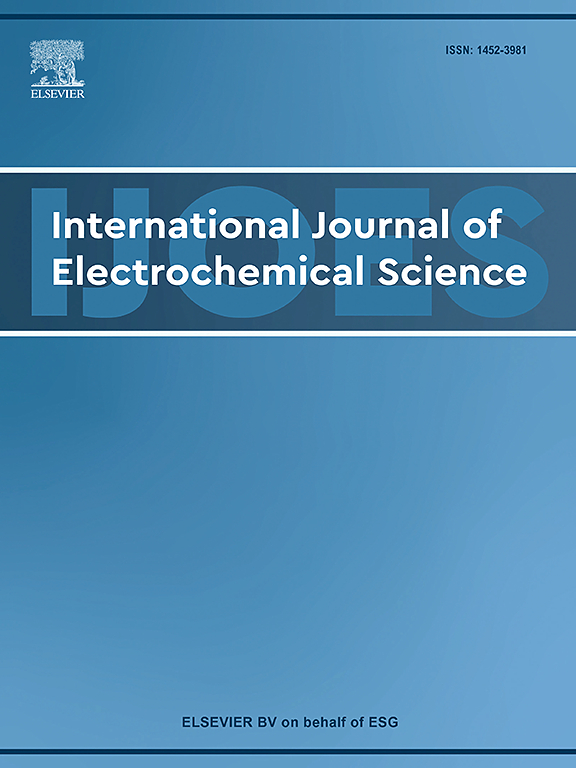Simultaneous electrochemical detection of Gd, Dy, and Eu using boron-doped diamond electrode combined with machine learning
IF 2.4
4区 化学
Q4 ELECTROCHEMISTRY
International Journal of Electrochemical Science
Pub Date : 2025-09-22
DOI:10.1016/j.ijoes.2025.101189
引用次数: 0
Abstract
Rare earth elements (REE) are currently high-demand mineral commodities for various countries. The electrochemical technique plays a crucial role in determining REE, offering high sensitivity compared to X-ray fluorescence spectrometry (XRF). This study aimed to detect the content of Gd, Dy, and Eu in a mixture without passing through a chemical separation, using the Differential Pulse Voltammetry (DPV) method and Boron Doped Diamond (BDD) working electrode combined with machine learning. A total of 125 variations of Gd, Dy, and Eu mixture solutions were prepared as the training set and measured using the DPV method. By employing the BDD working electrode, the current peak of Eu appeared separately from that of Gd and Dy, at a potential of −0.6 V. Meanwhile, Gd and Dy appeared in a single current peak at a potential of −1.4 V. Eu exhibited a Limit of Detection (LoD) and Limit of Quantification (LoQ) at 3.040 ppm and 9.211 ppm, Gd at 17.201 ppm and 7.475 ppm, as well as Dy at 22.652 ppm and 5.676 ppm, respectively. After algorithm selection and preprocessing in machine learning, the best model obtained was GLMNET for Eu with an R2 of 0.853, Dy at 0.376, and SVM for Gd with 0.557. These algorithms correctly predicted the closeness of the percentage recovery of the Gd, Dy, and Eu combination to the actual percentage recovery.
结合机器学习的掺硼金刚石电极同时电化学检测Gd、Dy、Eu
稀土元素(REE)是目前各国需求量很大的矿产品。电化学技术在测定稀土元素中起着至关重要的作用,与x射线荧光光谱法(XRF)相比,电化学技术具有高灵敏度。本研究旨在利用差分脉冲伏安法(DPV)和硼掺杂金刚石(BDD)工作电极结合机器学习,在不经过化学分离的情况下检测混合物中Gd, Dy和Eu的含量。共制备了125种Gd、Dy和Eu混合溶液作为训练集,并使用DPV法进行测量。采用BDD工作电极,在−0.6 V的电位下,Eu的电流峰与Gd和Dy的电流峰是分开出现的。同时,Gd和Dy在−1.4 V的电位下出现一个电流峰。Eu的检测限(LoD)和定量限(LoQ)分别为3.040 ppm和9.211 ppm, Gd分别为17.201 ppm和7.475 ppm, Dy分别为22.652 ppm和5.676 ppm。经过机器学习中的算法选择和预处理,得到的最佳模型为Eu的GLMNET, R2为0.853,Dy为0.376,Gd的SVM为0.557。这些算法正确地预测了Gd、Dy和Eu组合的百分比回收率与实际百分比回收率的接近程度。
本文章由计算机程序翻译,如有差异,请以英文原文为准。
求助全文
约1分钟内获得全文
求助全文
来源期刊
CiteScore
3.00
自引率
20.00%
发文量
714
审稿时长
2.6 months
期刊介绍:
International Journal of Electrochemical Science is a peer-reviewed, open access journal that publishes original research articles, short communications as well as review articles in all areas of electrochemistry: Scope - Theoretical and Computational Electrochemistry - Processes on Electrodes - Electroanalytical Chemistry and Sensor Science - Corrosion - Electrochemical Energy Conversion and Storage - Electrochemical Engineering - Coatings - Electrochemical Synthesis - Bioelectrochemistry - Molecular Electrochemistry

 求助内容:
求助内容: 应助结果提醒方式:
应助结果提醒方式:


